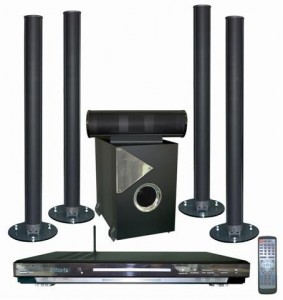Wireless home theater systems provide convenience and functionality for home theater owners. Although the term “wireless” really only means less wires in most cases, it still is a step up from the typical wire maze that most systems require. Sound systems for home theaters have become synonymous with confusing cable messes. A wireless approach to home theater is a way to clean up the clutter and make installation a breeze. As technology increases, electronics become easier to use, install, and enjoy.
Although electronic advancements are sure to come, the use of video and audio interconnects will probably stick around for several more years. Wireless systemsa are still in their infancy and still have some improving to do before they completely take over the wireless home theater system market. Quality, pricing, and security are among the main things that manufacturers will have to keep improving on until wireless systems can be delivered at a price that appeals to the average consumer. With that said, wireless tehnology is already helping in home entertainment. While the technology is not perfected it adds some distinct improvements and features that ordinary wired systems cannot.

Second, wireless speakers can clean up your wireless home theater speaker system room and make it look a whole lot better. Nothing is as tacky as running wires up the cracks and corners of your walls and over to the back of the room. While the sound is the most important thing, it can’t hurt to add a little class to the room itself. Wireless speakers look much better in a wireless home theater sound system setup, and make sense functionality wise.
To fully appreciate the technology behind wireless systems, it is important to realize that there is no completely wireless sytem out there. There are still some connectivity requirements to a power source. There are some battery-powered systems out there but these are usually for external use rather than inside your home. Batteries just cannot provide the required amount of power to be able to use a home theater sytem the way it was meant.
Wireless speakers require amplification through either an add on unit or an integrated amplifier. If you don’t have power than this is not even possible. So “wireless” systems have incorporated a mix of simple connective cables and wireless long range speakers. It gives flexibilty to room setup and allows for a customized sound experience. Integrated amplifiers are usually a cheaper alternative and include a wireless set-up for rear speakers and a well integrated overall system menu. Add on units consist of a smaller sender unit that connects to the A/V receiver, or to the line-level out. They use a wireless digital technology to transmit the signal to the back of the room. The rear units have built in amplifiers that drive the speakers. All that is required is to have the wireless sender and the receiver units plugged into main power outlets.
Rates and prices are variable when you consider accessories and add ons. Prices on a theater system with wireless speakers depends entirely upon what kind of quality of system you want. If you look at any of the top brands like Samsung, Sony, or Panasonic you will notice that each have top of the line systems and economically priced systems as well. On average you are looking at around $300 to $400 for a decent system. This will usually be a 5.1 surround sound system that includes two front speakers, two rear speakers and a subwoofer. To give an example, the Sony 5.1 channel Bravia System runs at about $429.99 and is backed by about 1000 watts of power while boasting HDMI connectivity. This particular product comes with a regular DVD player that can upconvert to 1080p. It comes with a few other accessories including a digital media port that allows you to hook up your ipod, pc, bluetooth, or any other auxiliary. Every system you look at will boast different accessories and a few unique features. The most important things to look at are the sound quality and power usage. If your system can deliver a powerful, deep sound at a healthy price than it is worth looking into.
Wireless systems for home theaters can be found all over the internet as well as in local electronic stores. Look for seasonal deals locally, and inventory blowouts online. With the current state of the economy it is a great time to look into investing in a wireless audio system. Rates are cheaper than they normally would be for electronics and companies need to get rid of older inventory that has been hard to sell in a time of recession. You can get great deals on the speaker systems as well as the televisions and other accessories. Take the time to do some research and comparisons on different systems that are out there. Don’t always go for the most expensive system on the market, some older systems provide quality sound and are much cheaper. With the right information you can make your home theater an enjoyable experience yourself as well as for family and friends.
Related Posts
<>







